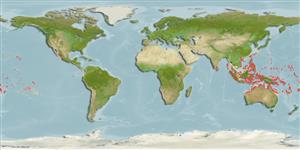>
Blenniiformes (Blennies) >
Blenniidae (Combtooth blennies) > Salariinae
Etymology: Nannosalarias: Latin, nannus = small + Greek krossoi = tassel + Latin, salar, salaris = trout (Ref. 45335).
More on author: Regan.
Environment: milieu / climate zone / depth range / distribution range
Ecologia
marino associati a barriera corallina; distribuzione batimetrica 2 - 12 m (Ref. 30874). Tropical; 30°N - 24°S
Indo-West Pacific: Christmas Island in the eastern Indian Ocean east to Samoa, north to the Ryukyu Islands, south to Rowley Shoals and the southern Great Barrier Reef and Tonga; Pohnpei in Micronesia.
Size / Peso / Age
Maturity: Lm ? range ? - ? cm
Max length : 5.0 cm TL maschio/sesso non determinato; (Ref. 9710)
Spine dorsali (totale): 12; Raggi dorsali molli (totale): 15-16; Spine anali 2; Raggi anali molli: 16 - 18. Identified by a simple tentacle above eye, small white spots on face and large black spot on throat (Ref. 48636). Males have a distinct black blotch ventrally on each side of the head.
Adults found solitary or in small groups in seaward reef crests and outer reef slopes in exposed shallow reef fronts subject to mild to moderate surge (Ref. 48636, 90102). Oviparous. Eggs are demersal and adhesive (Ref. 205), and are attached to the substrate via a filamentous, adhesive pad or pedestal (Ref. 94114). Larvae are planktonic, often found in shallow, coastal waters (Ref. 94114). Minimum depth of 2 m reported from Ref. 90102.
Life cycle and mating behavior
Maturità | Riproduzione | Deposizione | Uova | Fecundity | Larve
Oviparous, distinct pairing (Ref. 205).
Myers, R.F., 1991. Micronesian reef fishes. Second Ed. Coral Graphics, Barrigada, Guam. 298 p. (Ref. 1602)
IUCN Red List Status (Ref. 130435)
Threat to humans
Harmless
Human uses
Informazioni ulteriori
BibliografiaAcquacolturaProfilo di acquacolturaVarietàGeneticaElectrophoresesEreditarietàMalattieElaborazioneNutrientsMass conversion
CollaboratoriImmaginiStamps, Coins Misc.SuoniCiguateraVelocitàModalità di nuotoArea branchialeOtolithsCervelliVista
Strumenti
Special reports
Download XML
Fonti Internet
Estimates based on models
Preferred temperature (Ref.
123201): 25.4 - 29.3, mean 28.6 °C (based on 2273 cells).
Phylogenetic diversity index (Ref.
82804): PD
50 = 1.0000 [Uniqueness, from 0.5 = low to 2.0 = high].
Bayesian length-weight: a=0.00741 (0.00335 - 0.01640), b=3.02 (2.83 - 3.21), in cm total length, based on LWR estimates for this (Sub)family-body shape (Ref.
93245).
Trophic level (Ref.
69278): 2.0 ±0.00 se; based on food items.
Resilienza (Ref.
120179): Alto, tempo minimo di raddoppiamento della popolazione meno di 15 mesi (Preliminary K or Fecundity.).
Fishing Vulnerability (Ref.
59153): Low vulnerability (10 of 100).
Nutrients (Ref.
124155): Calcium = 272 [131, 542] mg/100g; Iron = 1.18 [0.63, 2.20] mg/100g; Protein = 17.7 [16.5, 18.9] %; Omega3 = 0.0883 [, ] g/100g; Selenium = 24.7 [10.2, 61.5] μg/100g; VitaminA = 115 [26, 496] μg/100g; Zinc = 3.64 [2.28, 5.53] mg/100g (wet weight);
